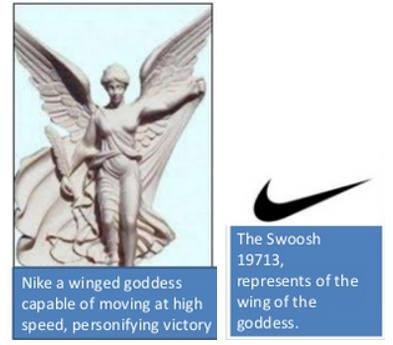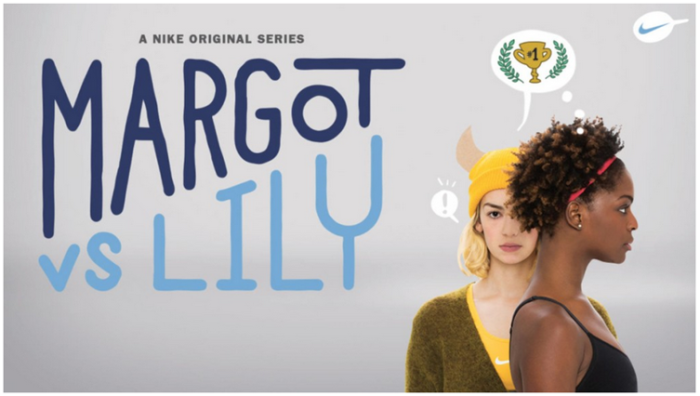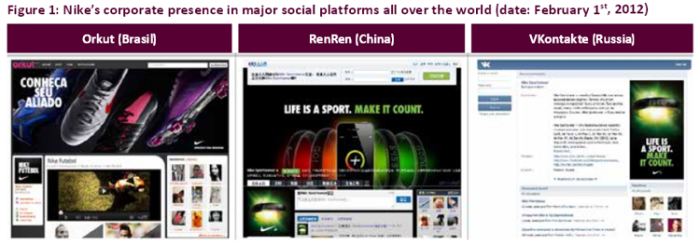Nike Inc. was founded in 1962 by Bill Bowerman and Phil Knight as a partnership under the name, Blue Ribbon Sports.. In existence for over 40 years, today, Nike is the largest seller of apparel, athletic footwear, and equipment in the world. Like many companies of that era, Nike had a humble beginning.
Brand Awareness
- NIKE is an international brand that is recognized everywhere by their trademark “swoosh” logo.
- There is over 700 NIKE stores worldwide.

Value Proposition
NIKE, Inc. is the world’s leading innovator in athletic footwear, apparel, equipment and accessories.Their mission is quite simple:
“TO BRING INSPIRATION AND INNOVATION TO EVERY ATHLETE* IN THE WORLD.
*IF YOU HAVE A BODY, YOU ARE AN ATHLETE.” NIKE.com
NIKE’s brand portfolio also includes several brands developed or acquired by it. Most famous of them are
- ‘Jordan’ – targets basketball-related products & named after basketball superstar Michael Jordan
- ‘Hurley’ – youth-focused brand targeted at action sports like surfing, skateboarding and many more
- ‘Converse’ – a wholly owned subsidiary brand dealing in apparel, casual sneakers, and accessories

Lebron James x MVP Shoe
Segmentation:
Nike falls under niche marketing. They have a narrowly defined customer group seeking a distinctive mix of benefits. Their products are mainly aimed at both men and women looking for sports apparel. Nike promises their customers comfort, reliability, style and performance.
Nike sports shoes are priced high. But customers are willing to spend the extra money for the quality and service they receive.
Nike pays top athletes in many different sports to use their products and promote/advertise their technology and design. Nike is the official kit sponsor for the Indian cricket team for 5 years, from 2006 till end of 2010. Nike beat Adidas and Puma by bidding highest. Nike also sponsors some of the leading clubs in world football, such as
Manchester United, Arsenal, FC Barcelona, Inter Milan, Juventus, Shakhtar, Porto, Steaua, Red Star, Club América, Aston Villa, Celtic and PSV Eindhoven. Nike sponsors several of the world’s top golf players, including Tiger Woods, Trevor Immelman and Paul Casey.
Targeting:
- Broadly, NIKE has products for people from all age-groups: right from newborns & kids to teenagers, adults and even the old. For example, any new revolutionary designed footwear is generally released for all age groups. However, its core focus is on people in the age group of 18-35 years old.
- By opening women’s-only stores in California, Shanghai, etc., Nike has started expanding its presence in the women apparel market because of its untapped potential
Positioning:
The Positioning statement of Nike is “For serious athletes, Nike gives confidence that provides the perfect shoe for every sport”.
Nike positions itself with, “Just do it.” Nike has waved the just do it banner for over 20 years. They continue to find new and amazing ways to say it repetitively without boring their audience. Their position gives them permission to express something that is powerful. Just do it belongs to the customer—people love that. To be able to just do it makes you want to jump hurdles or sprint a marathon.
Marketing Campaigns:
For years, Nike successfully relied on large print and television advertising campaigns that celebrated a single hit, whether it be one of their new products or one of their sponsors. The taglines “Just Do It” and “Bo Knows” became synonymous with the Nike brand, instantly recognizable. Now, however, Nike has moved away from these types of advertisements. From 2009 to 2012, Nike’s spending on traditional advertising dropped by 40% and decreased ever since, even as its marketing budget grew to a company record of $2.4 billion. Where is all of that money going?
Answer: to advertising techniques that take advantage of new technologies and that allow them to communicate directly with their target audience—17-year olds who spend 20% more on shoes than their adult counterparts.
Margot vs. Lily
Nike launched 8 episode series called “Margot vs. Lily” on YouTube, which focuses on a pair of interracial, adopted sisters: one an athletic junkie with few social skills and the other an outgoing woman who has little interest in sporty pursuits.
The whimsical story focuses a bet placed between the two sisters Margot must start a fitness channel and get 1,000 followers, while Lily (who already runs a popular video blog) is challenged to find three real friends. Both girls struggle to achieve their goals.
The series is one of several ways that Nike is reaching out to millennial-aged women, a core group of shoppers that have been persuaded to wear athletic gear not just for activity, but also while out on the town. Nike has free digital apps with training programs and tips, running clubs, and a broader “Better For It” campaign that aims to encourage women to get more involved in sports. Nike also has a weekly newsletter targeted to women, called “The Fix.”

Message of defiance during the financial crisis of Greece:
Nike is weighing in on the Greek economic crisis with a haunting new ad featuring four competitive athletes from the debt-stricken country.
It’s a visually arresting piece, set in desolate venues from the 2004 Athens Olympics—expensive projects that have fallen into disrepair, becoming symbols of short-sighted government overspending in the years leading up to the nation’s current predicament.
In the ad, swimmer Eleni Hatzimitrou, Paralympic runner Michalis Seitis, NBA player Giannis Antetokounmpo and pole vaulter Nikoleta Kyriakopulou prepare to ply their craft. A voiceover, delivered in Greek, spits defiance as the tension builds.
“We will not be defined by circumstance,” read the English captions. “We will not be undone by what is broken. We are more than our surroundings. We are the makers of our fate.”
The athletes take off as lightning crackles in the background and war drums beat with enough drama for a high-budget Hollywood movie based on an ancient Greek myth.
Nike’s classic tagline, “Just do it,” follows as Antetokounmpo lands after a crushing dunk.

Nike’s Social Media Initiatives
In 2008, Nike created its Facebook account. Today, Nike maintains a Facebook page for each sub-brand, running product specific promotions, featuring events in a particular sporting activity, and also providing information on the latest game of endorsed athletes. For example, a Facebook user who desires to know more about the latest football shoes or game can turn to Nike Football Facebook page.
Pairing up with Apple Inc. – a company known for its innovative products, helped Nike by increasing brand awareness and also reaching out to customers who were still in two minds about choosing their brands by bringing into its fold the Facebook fans of Apple. The tie-up with Apple was Nike’s realization that most runners will use iPods or iPhones to listen to music while jogging. Apple’s iPhones and iPods thus came pre-installed with Nike+ app. With this, iPhone/iPod users can map out their running route and later share it with their Facebook friends.
Digital sport:
Nike Digital Sport is a relatively new division at Nike, launched in 2010 (the same year they spent $800 million on nontraditional advertising), which focuses on developing technology and devices that enable users to track their personal fitness statistics. The most well-known component of Digital Sport is the Nike+ running sensor, which was developed with Apple. The product has at least six million users. Nike+ tracks athletic performance through a wireless connection. Data is stored on the Nike website and users can post and share their workout information via Twitter and Facebook. It requires a Nike+ sensor, Nike+-compatible footwear, and a Nike+ tracking device. More recently, Nike has created the FuelBand, which measures energy output.





A very crispy, short and sweet brand analysis